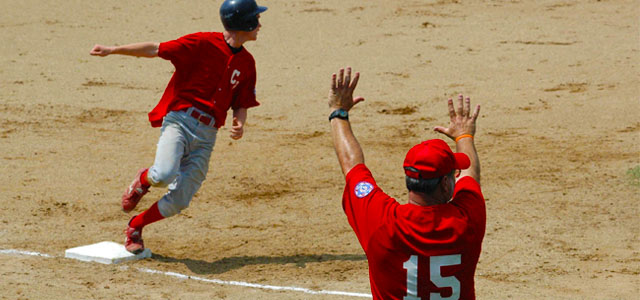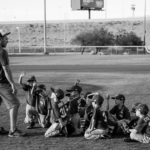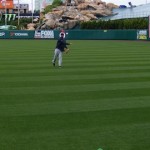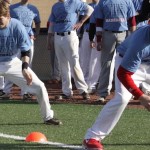After posting Sound Off last week, we received some good feedback about what baseball topics interest you the most. We received a few comments on the post itself and received some emails about what coaches and players would like to learn about the game. Here is one of the emails we received:
2 outs, runners on 2 and 3
I’d be interested to get your opinion on the situation above. Normally in youth baseball you hear coaches yell, “2 down, run on anything.” If you have 2 down, runners on 2nd and 3rd, and if the ball is hit to the shortstop or the third baseman, wouldn’t you want your runners to avoid running into an easy tag or throw to third/home?, especially as kids get older and become better ballplayers. I appreciate your opinion.
Thanks,
Jeff
Asst. Coach 12u

Thanks for the email and question, Jeff. Let me give you the simple and straight forward answer first. You never run into an out. The situation does not matter. If a defensive player can make a simple tag play on the runner, the runner should not continue to run.
Let’s break it all down.
Why it’s Taught
The mentality of run on anything with 2 outs is often taught at the lower stages of baseball when kids are first learning the game. Many first time ballplayers do not fully understand the game yet, so coaches make it easy for kids to remember by yelling this simple phrase from the dugout or 3rd base coach’s box. Coaches get frustrated when they see a kid still standing on 2nd base, with two outs, and the batter had hit a fly ball or gets a base hit. So, they remind the runners, “There are two outs. Run on anything hit!”
Believe it or not, this works great at the beginning levels of baseball. In the situation you describe with runners on 2nd and 3rd, even if the ball is hit to the shortstop, chances are he will have a tough time making the play at third. Let’s not forget, the shortstop’s coach has probably told him that if there are 2 outs, the easiest play is at first base for the routine force out.
The Correct Approach
As players mature and understand the game better, this situation becomes slightly more complicated. I only say slightly, because if taught correctly, you should never have problems during this situation. Let’s look at the different approach the runner on 3rd should have compared to the runner on 2nd.
The Runner on 3rd
At the higher levels and with two outs, chances are the infielders are playing at normal depth. In a close game with less than two outs, the infield will typically play in for a better chance to cut down the runner at home. However, this defensive tactic works best when the ball is hit almost directly at the fielder. Most hard-hit groundballs hit to either side of a fielder are tougher to field and throw a runner out at home. In a 2 out situation, the fielders will be playing at normal depth so they can have good range on groundballs in either direction. There is no need to cut the runner down at home, when a simple force play at first base will end the inning. So, with 2 outs, the runner on 3rd should recognize the situation and make sure the infield is, in fact, playing at normal depth. Knowing the easiest play is at first on a routine groundball, the runner should be running on contact.
There is only one situation when the runner on 3rd should hesitate before attempting to score. If the ball is put into play on a check swing or swinging bunt and travels slowly down the 3rd baseline, the force play at 1st base will be tougher to make. A sharp infielder will realize this and attempt to put out the runner on 3rd if he is running on contact. In this case, the three most likely fielders to make a play on the ball are the pitcher, catcher, or 3rd baseman. The runner on 3rd should recognize that running on contact may have him running into an easy tag play. Instead, he should wait to see how the play develops. If he holds back even for a split second, the fielder has to make an attempt to get the runner out at first to end the inning. Then, and only then, the runner should attempt to score.
The Runner on 2nd
The runner on 2nd base has a little more to think about in this situation. We already know the infielders will be playing at normal depth, and we know the defense wants to make the easy force play at first on a routine groundball. However, the runner needs to know that his approach to advancing on the base paths is dependent upon where the ball is hit as well. With 2 outs, he should be running on anything hit in the air and anything hit to the right side of the field. Where he needs to be more aware is on the ground ball hit to the shortstop or third baseman.
A ball hit to the third baseman is an automatic freeze-and-wait until the fielder makes the long throw across the diamond to first. This should not be hard to understand because, once again, you never run into an out. Running on a groundball to third would result in an easy tag play for the fielder.
If the ball is hit to the shortstop, the runner has to recognize if it is behind him or in front of him. In other words, does that shortstop have to travel to his right or left in order to make the play. If the ball is hit behind the runner (more towards the 2nd base bag), he should be able to advance easily to 3rd base as the shortstop has an easier play at first because his momentum is taking him that direction. Now, if the groundball is in front of the runner, the shortstop most likely has to travel to his right to make the play. If the shortstop is moving to his right (towards 3rd base), he will have a tougher throw to make to first because he will have to throw across his body as his momentum takes him away from first base. So the easier play for him is on the runner who is trying to advance from 2nd to 3rd.
The runner needs to realize the situation is fluid and if the ball is hit in front of him, he needs to wait for the infielder (SS or 3rd baseman) to make the play at first. Once he sees the fielder release the ball towards first, then he can advance to third. He should also be aware of an overthrow on the play and look to score if this happens.
One More Thing to Note
It’s always good to know your opponent. Are certain opposing players more aware of their surroundings? Do they know the game well? A smart infielder who recognizes that he does not have a play at first, can fake the throw and turn around to find the base runner caught by surprise. As the base runner, whether on 2nd or 3rd, if you find yourself having to wait on the infielder to make his throw, make sure you see the ball leave his hand. Then, you can make your break for the next base. Remember, there is no force situation and you never run into an out, so if he doesn’t make the throw and you do not advance, there is no harm done. You now have bases loaded with two outs.






One response to “Q & A: 2 Outs, Run on Anything?”
on a dropped third strike to the batter with a man on third and less than 2 outs would you attempt to throw the runner out at first, knowing that the runner at third will likely score?